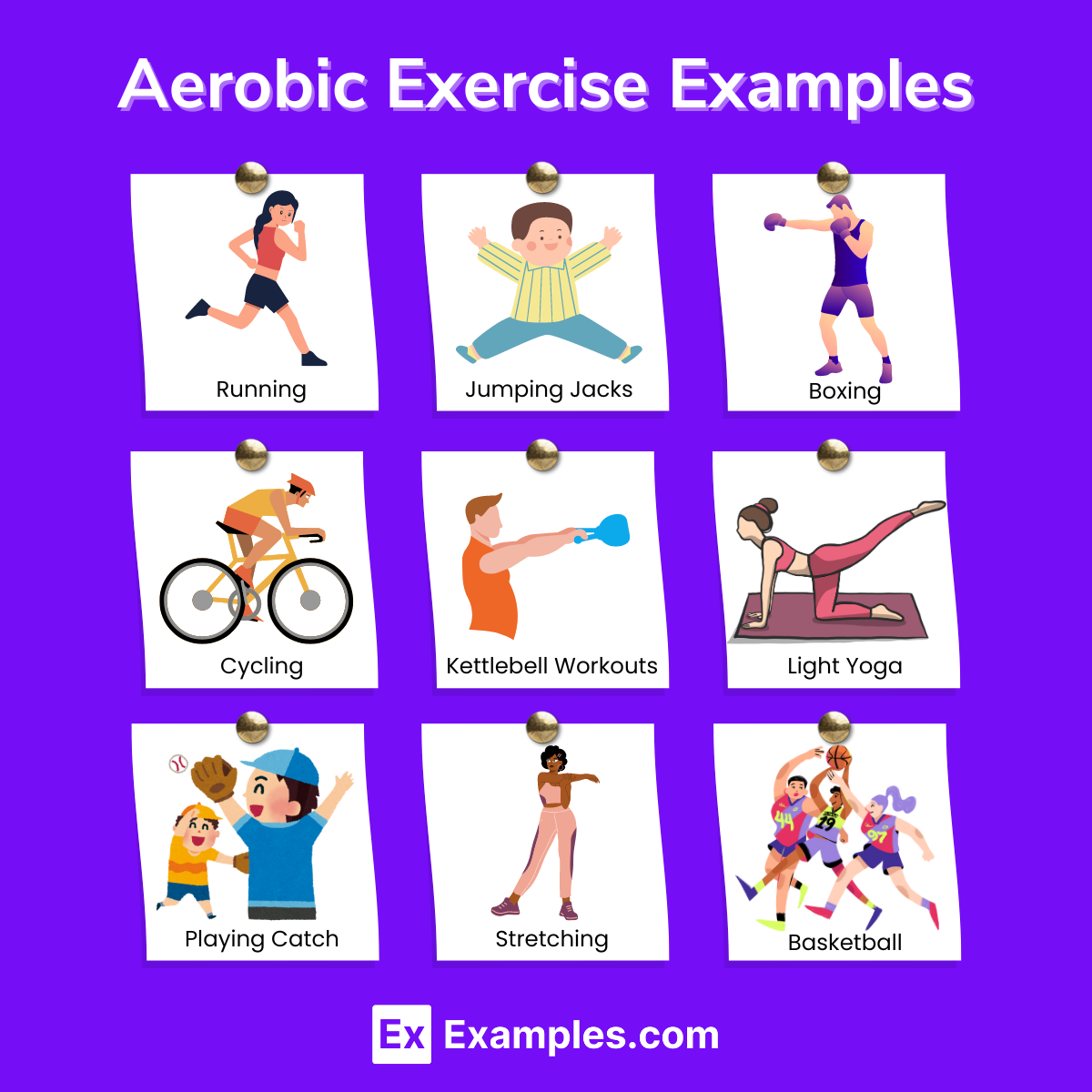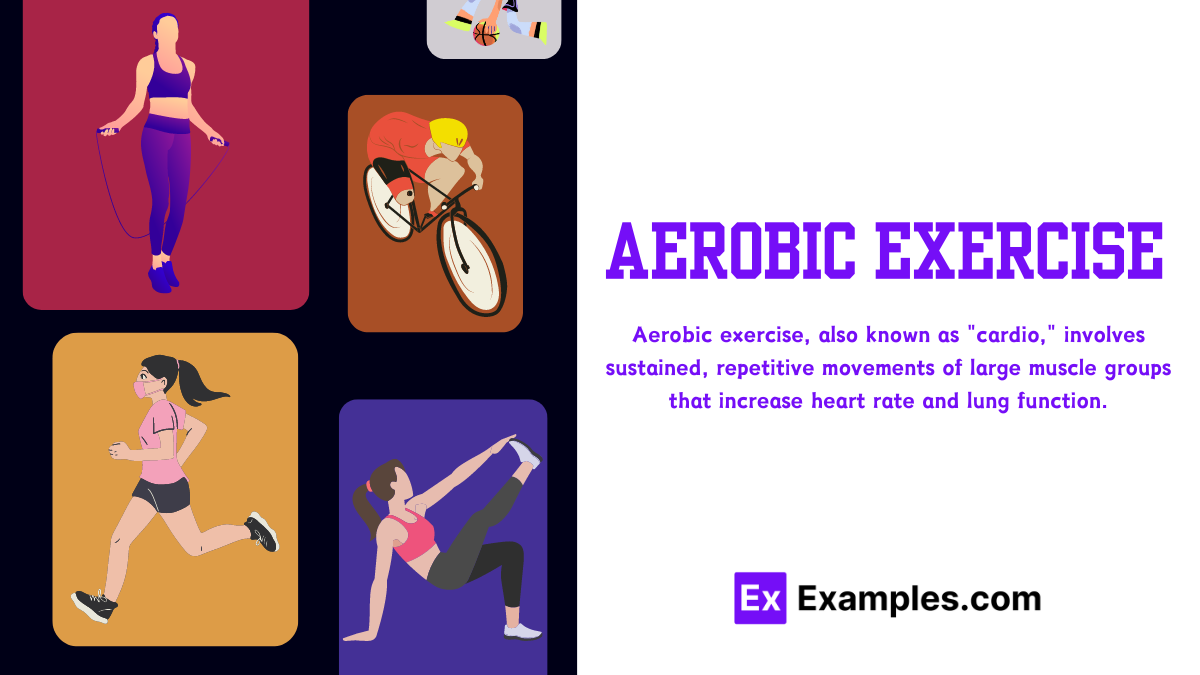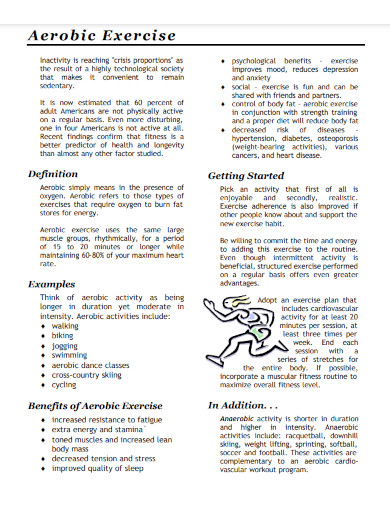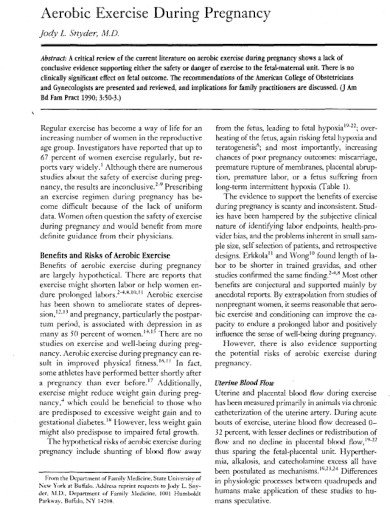50+ Aerobic Exercise Examples
There are a lot of diseases and problems that are linked to obesity and a sedentary lifestyle. This is why there is a large resurgence of call to actions linked to exercise and dieting. Start improving your quality of life by interacting and doing aerobic exercises.
What is Aerobic Exercise?
Aerobic exercise, also known as “cardio,” involves sustained, repetitive movements of large muscle groups that increase heart rate and lung function. The term “aerobic” means “with oxygen,” indicating that breathing controls the amount of oxygen that can make it to the muscles to help them burn fuel and move. Aerobic exercises are specific types of activities that utilize specific actions that put a large focus on breathing. One will be able to convert potential energy to kinetic energy through the system of mechanical energy via the interaction of oxygen and one’s muscles. This type of exercise has a lot of health benefits that can even reduce one’s anxiety and resistance.
Aerobic Exercise Examples

At Home
- Jumping Jacks: A full-body workout that involves jumping with legs spread wide and hands touching overhead, then returning to a position with feet together and arms at the sides.
- High Knees: Running in place while lifting your knees as high as possible.
- Burpees: A full-body exercise involving a squat, jump, and push-up.
- Mountain Climbers: A form of cardio that mimics climbing motions while in a push-up position.
- Dancing: Freeform or structured dance moves to elevate the heart rate.
- Skipping Rope: Jumping over a rope swung under the feet and over the head in a rhythmic pattern.
- Step Aerobics: Using a platform to step up and down while performing various aerobic movements.
- Jogging in Place: Running in a stationary position to increase heart rate.
- Shadow Boxing: Punching the air as if boxing against an opponent.
- Kickboxing Workouts: Combining martial arts techniques with heart-pumping cardio.
- Aerobic Dance Videos: Following dance-based workout routines provided in videos.
- Bodyweight Squats: Standing exercises where you lower your body into a squat position and then stand back up.
- Arm Circles: Rotating the arms in circles to engage the shoulders and upper body.
- Jump Rope (without a rope): Mimicking the motion of jumping rope without the actual rope.
- Virtual Fitness Classes: Participating in online classes that focus on aerobic exercises.
For Beginners
- Walking Briskly: A simple form of aerobic exercise that involves walking faster than a casual pace to raise the heart rate.
- Swimming: Engaging in various strokes in water that work the entire body and improve cardiovascular health.
- Cycling on a Stationary Bike: Using a stationary cycle to pedal at a steady pace.
- Low-impact Aerobics: Aerobic exercises that are easier on the joints, involving movements with minimal ground impact.
- Aqua Aerobics: Performing aerobic exercises in a swimming pool, which reduces stress on joints.
- Tai Chi: A series of flowing movements performed slowly and gently to enhance balance and fitness.
- Rowing on a Machine: Using an indoor rower to mimic the action of watercraft rowing.
- Elliptical Trainer: Using this machine to simulate walking or running without causing excessive pressure on the joints.
- Light Jazzercise: A dance-based workout that combines jazz dance and exercise moves, tailored for beginners.
- Stair Climbing at a Slow Pace: Using stairs at a slow and steady pace.
- Low-impact Dance Classes: Engaging in dance that limits strenuous jumps and fast movements.
- Seated Exercises: Performing exercises while seated to reduce strain on the legs and back.
- Gentle Stretching: Incorporating light stretching movements to improve flexibility and blood flow.
- Balloon Ball Activities: Using a balloon to engage in light, playful activities that involve hitting or catching.
- Walking with Light Hand Weights: Adding small hand weights to a walking routine to increase the intensity gently.
For Weight Loss
- Interval Running: Alternate between sprinting and jogging. This high-intensity interval training (HIIT) helps burn calories efficiently.
- Zumba: A dance-based workout that’s fun and effective for burning calories and improving cardio.
- Circuit Training: Rotate through a series of exercises with minimal rest in between, targeting different body parts for a comprehensive workout.
- Spin Classes: Indoor cycling classes that focus on endurance and cardiovascular fitness, great for burning a high number of calories.
- Boxing: Engaging in boxing provides a vigorous cardio workout that also helps reduce stress.
- Stair Climbing: Utilize stairs for a challenging workout that boosts metabolism and tones the lower body.
- Power Yoga: A dynamic form of yoga that improves strength, flexibility, and endurance while also burning calories.
- Aerobic Dance Classes: High-energy classes that use choreographed movements to raise heart rate and burn calories.
- CrossFit: Includes varied functional movements performed at high intensity, excellent for weight loss and overall fitness.
- Kettlebell Workouts: Combine cardio and strength training, which helps to burn calories and increase muscle tone.
- Jumping Rope: A high-intensity activity that improves cardiovascular health and burns a lot of calories in a short time.
- Rowing: Engages large muscle groups and is effective for burning calories and improving cardiovascular health.
- Aqua Jogging: Running in the water provides resistance that helps burn more calories than traditional running.
- HIIT Workouts: Short bursts of intense exercise followed by recovery periods, known for high caloric burn in a short period.
- Rollerblading: Offers a fun and effective cardiovascular workout that also helps tone the legs and core.
For the Elderly
- Walking: Gentle on the joints and can be done anywhere.
- Aqua Aerobics: Water resistance provides a good workout while being easy on the joints.
- Chair Aerobics: Allows those with limited mobility to exercise while seated.
- Stationary Cycling: Low impact and helps improve leg strength and cardiovascular health.
- Light Yoga: Focuses on flexibility and balance, important for aging bodies.
- Tai Chi: Gentle martial arts that focus on slow, controlled movements to improve balance and strength.
- Dance Therapy: Encourages movement and flexibility through dance, suitable for all fitness levels.
- Stretching and Flexibility Exercises: Helps maintain range of motion and reduce stiffness.
- Balloon Volleyball: A fun, low-impact game that can be played seated or standing.
- Marching in Place: Helps increase circulation and can be done while watching TV.
- Leg Lifts: Can be performed seated or standing to strengthen the lower body.
- Arm Raises: Using light weights or no weights to build upper body strength.
- Pedal Exercisers: Small exercise machines for arms or legs, ideal for seated workouts.
- Resistance Band Exercises: Gentle on the joints while improving strength and flexibility.
- Simple Pilates Moves: Modified to suit older adults, focusing on core strength, balance, and flexibility.
Easy Ones
- Walking: One of the simplest and most accessible forms of aerobic exercise.
- Swimming: Low impact and suitable for all fitness levels, helping to improve endurance and muscle tone.
- Slow Cycling: Gentle on the joints and a good way to enjoy the outdoors or use a stationary bike indoors.
- Low-Impact Aerobics: Includes movements that are less strenuous on the body.
- Hiking: Walking in nature, can be adjusted to a comfortable pace and difficulty.
- Dancing: Choose a style with simpler moves and a slower pace.
- Gentle Yoga: Focuses on breathing and slow movements, good for stress relief and flexibility.
- Rowing at a Moderate Pace: Provides a full-body workout without high impact.
- Elliptical Training: Mimics the natural path of the ankle, knee, and hip joints, providing a low-impact cardiovascular workout.
- Leisurely Walking Groups: Join a group for social interaction and motivation.
- Playing Catch: Gentle tossing and catching a ball for light exercise.
- Gardening: Can be a surprising aerobic activity, involving walking, bending, and stretching.
- Nordic Walking: Walking with poles to engage upper body muscles.
- Stretching Classes: While primarily for flexibility, they can also raise the heart rate if done in sequence.
- Bocce Ball: A light, engaging game that can be played at a leisurely pace.
High Intensity Aerobic Exercises
- Sprinting: Short bursts of running at full speed, effective for building endurance and speed.
- Interval Running: Alternating between sprinting and jogging or walking to maintain a high heart rate.
- HIIT (High Intensity Interval Training): Includes various exercises performed in short, intense bursts followed by brief recovery periods.
- Tabata Workouts: A form of HIIT consisting of 20 seconds of ultra-intense exercise followed by 10 seconds of rest, repeated for four minutes.
- Agility Ladder Drills: Fast-paced footwork exercises that improve speed, agility, and cardiovascular health.
- Kickboxing: Intensive routines that combine martial arts techniques with fast-paced cardio.
- Spinning: High-speed cycling classes that often feature intervals and resistance changes.
- CrossFit: Combines elements of weightlifting, sprinting, and high-intensity movements.
- Plyometrics (Jump Training): Exercises that involve explosive jumping movements, increasing power and speed.
- Insanity Workouts: A series of bodyweight exercises performed in intense intervals, designed to improve fitness quickly.
High Impact Aerobic Exercises
- Box Jumps: Jumping onto and off a sturdy box to engage the lower body intensely.
- Burpees with a Jump: Adding a high jump into the standard burpee exercise to increase its intensity.
- Skipping Rope: High-speed skipping which can include double unders (rope passes under feet twice per jump) or criss-crosses.
- Running Stairs: Rapidly ascending and descending stairs to build power and endurance.
- Basketball or Soccer: Playing sports that involve quick sprints, jumps, and direction changes.
- Dance Aerobics: High-energy dance routines that involve jumping and fast movements.
- Tuck Jumps: Jumping from a standing position and pulling the knees to the chest while in the air.
- Hurdle Drills: Running and jumping over hurdles to improve coordination and leg power.
- Tennis or Squash: Sports that require quick sprints and stops, providing a high-impact workout.
- Volleyball: Includes jumping and sprinting, making it a high-impact sport that improves agility and coordination.
Benefits of Aerobic Exercise
Physical Health Improvements
Cardiovascular Fitness: Aerobic exercise strengthens the heart and improves the efficiency of the cardiovascular system to pump blood throughout the body. This can reduce the risk of heart disease, hypertension, and stroke.
Weight Management: Engaging in aerobic activities helps burn calories and fat, aiding in weight management and reducing the risk of obesity.
Enhanced Respiratory Efficiency: Regular aerobic exercise increases the capacity of the lungs and improves overall respiratory function, which is beneficial for overall health and stamina.
Mental Health Benefits
Stress Reduction: Aerobic exercise is known to decrease stress levels, thanks to the release of endorphins, often referred to as “feel-good” hormones.
Improved Mood and Mental Health: Regular aerobic activity can alleviate symptoms of depression and anxiety and promote a more positive mood.
Cognitive Enhancement: There is evidence that aerobic exercise can improve brain function, enhance memory, and reduce the risk of cognitive decline with aging.
Metabolic and Hormonal Benefits
Improved Metabolism: Aerobic exercise helps increase the rate at which your body uses energy, which can boost metabolism over time.
Better Blood Sugar Control: It helps in managing blood sugar levels, reducing the risk of type 2 diabetes and helping those already diagnosed with diabetes to manage their condition.
Social and Lifestyle Benefits
Increased Energy Levels: Regular aerobic activity can boost your overall energy levels, making it easier to maintain an active lifestyle.
Social Interaction: Many aerobic exercises, like group fitness classes or team sports, provide opportunities for socializing, which can enhance your quality of life.
Improved Sleep Patterns: Engaging in regular aerobic exercise can help improve the quality of sleep, helping you fall asleep faster and deepen your sleep.
Differences Between Aerobic and Anaerobic Exercises
| Aspect | Aerobic Exercise | Anaerobic Exercise |
|---|---|---|
| Definition | Involves continuous, rhythmic activity performed for extended periods. | Consists of bursts of high-intensity activity followed by rest or low activity. |
| Oxygen Use | Uses oxygen to meet energy demands during exercise. | Does not rely primarily on oxygen; energy is produced anaerobically. |
| Duration | Long duration (several minutes to hours). | Short duration (usually between 30 seconds and 2 minutes). |
| Intensity | Low to moderate intensity, allowing sustained effort. | High intensity, typically unsustainable for long periods. |
| Energy Source | Primarily burns fats and carbohydrates with a steady supply of oxygen. | Uses stored ATP, creatine phosphate, and muscle glycogen as energy sources. |
| Examples | Running, cycling, swimming, walking, rowing. | Sprinting, weightlifting, high-intensity interval training (HIIT). |
| Impact on Body | Increases cardiovascular endurance and promotes fat burning. | Increases muscle strength, size, and power; enhances short-term endurance and speed. |
| Recovery Time | Generally requires less recovery time; cooldown period is often sufficient. | Requires longer recovery times due to high intensity and lactic acid build-up. |
| Effect on Muscles | Primarily improves the efficiency of the heart and lungs. | Primarily increases muscle mass and anaerobic endurance. |
| Breathing Pattern | Steady and deep; can be maintained during the exercise. | Often rapid and labored; difficult to sustain during the exercise. |
| Fatigue Level | Builds up gradually, allowing for longer duration before exhaustion. | Fatigue builds quickly due to intense exertion and lactic acid accumulation. |
Risks of Aerobic Exercise
Physical Risks
Injury: Engaging in aerobic exercise, especially without proper warm-up or with poor form, can lead to injuries such as sprains, strains, or stress fractures. High-impact activities like running or jumping are particularly associated with these risks.
Overexertion: Pushing the body too hard during exercise can lead to overexertion, which can cause exhaustion, dehydration, or heat-related illnesses, especially in hot and humid weather.
Cardiovascular Stress: Although aerobic exercise is beneficial for cardiovascular health, it can sometimes put excessive stress on the heart, especially in individuals with pre-existing heart conditions or those who perform intense exercise without proper progression.
Health Condition Complications
Aggravation of Pre-existing Conditions: Individuals with chronic health issues such as arthritis, heart disease, or respiratory problems may experience worsening symptoms if they engage in inappropriate levels or types of aerobic exercise.
Hypoglycemia in Diabetics: People with diabetes might experience drops in blood sugar levels during or after exercise, which can be dangerous if not monitored and managed properly.
Psychological Risks
Mental Fatigue: Overdoing aerobic exercise can lead to mental fatigue and decreased motivation, especially if it becomes a compulsive need rather than a healthy habit.
Exercise Addiction: While rare, some individuals may develop an unhealthy obsession with exercise, which can lead to physical and psychological issues, including neglect of personal and professional responsibilities.
General Considerations
Inadequate Recovery: Insufficient rest and recovery between exercise sessions can lead to a state of chronic fatigue, impairing both physical performance and health.
Improper Exercise Techniques: Using incorrect form or equipment during aerobic workouts can increase the risk of injury and decrease the effectiveness of the exercise.
Guidelines for Safe Aerobic Exercise
Pre-Exercise Preparations
Medical Clearance: Before beginning any new exercise program, particularly if you have pre-existing health conditions or are new to strenuous activity, consult with a healthcare provider.
Proper Attire: Wear appropriate clothing and footwear specific to your activity. Proper footwear can help prevent injuries by providing adequate support and cushioning.
Warm-Up: Begin each exercise session with a warm-up to gradually increase your heart rate and loosen your muscles and joints. This can include light aerobic activity and dynamic stretches.
During Exercise
Follow Proper Technique: Ensure that you are using correct form to avoid injuries. If unsure, consider seeking advice from a fitness professional.
Stay Hydrated: Drink water before, during, and after exercise to stay hydrated, especially in hot and humid conditions to avoid dehydration.
Monitor Intensity: Use tools like the talk test or heart rate monitors to gauge exercise intensity. Ensure you can carry on a light conversation; if you’re too out of breath to speak smoothly, you may be pushing too hard.
Post-Exercise Care
Cool Down: After aerobic activity, include a cool-down phase with slower movements and stretches to help your body transition to a resting state.
Rest and Recovery: Allow your body adequate time to recover between workouts to prevent overuse injuries. Incorporating rest days is crucial for muscle recovery and performance improvement.
Listen to Your Body
Recognize Pain and Discomfort: While some muscle soreness after a new or intense workout is normal, sharp pain or discomfort that lasts more than a few days should be addressed by a professional.
Adapt as Needed: Adjust your exercise routine in response to bodily feedback and external conditions, such as weather. For example, scale back during extreme heat or if you feel unusually tired or unwell.
Maintain a Balanced Routine
Include Variety: Incorporating different types of aerobic activities can prevent boredom and reduce the risk of overuse injuries. Consider mixing high-impact exercises with low-impact activities, such as swimming or cycling.
Gradual Progression: Increase the intensity and duration of your workouts gradually to avoid excessive strain on your body.
Frequency of Aerobic Exercises
Recommended Frequency
For most adults, the American Heart Association recommends at least 150 minutes of moderate-intensity aerobic activity or 75 minutes of vigorous aerobic activity per week, preferably spread throughout the week. This translates to about 30 minutes a day, five days a week if you’re doing moderate-intensity activity. More frequent exercise can provide additional health benefits, depending on your goals and physical condition.
Adjusting Frequency Based on Goals and Fitness Levels
- Beginners: If you’re new to exercising, you might start with shorter sessions (like 10-15 minutes) of aerobic exercise 3 times a week, gradually increasing the duration and frequency as your fitness improves.
- Weight Loss or High Fitness Goals: For those aiming for weight loss or higher levels of physical fitness, you might need to increase the intensity and duration of your workouts, potentially exercising most days of the week.
Importance of Variety and Rest
While it’s beneficial to engage regularly in aerobic exercise, it’s also important to allow your body time to recover. Incorporating rest days, especially after intense workouts, helps prevent overtraining and injuries. Additionally, varying the types of aerobic activities can keep the exercise routine enjoyable and reduce the risk of overuse injuries.
Do I need to go to a gym to do aerobic exercises?
No, you do not need to go to a gym to do aerobic exercises. Aerobic activity, aimed at improving cardiovascular health, can be performed anywhere. Simple and effective aerobic exercises like walking, running, dancing, or cycling can be done outdoors or in the comfort of your own home. With the availability of online workout videos and apps, you can also follow guided aerobic routines without the need for gym equipment. This flexibility allows you to maintain an aerobic exercise regimen that fits your lifestyle and preferences, ensuring you can stay active and healthy.
Aerobic Exercise Template
Aerobic Exercise During Pregnancy
How to Plan Out Aerobic Your Aerobic Exercise Schedule
Aerobic exercise is easy to do, due to its low barrier of entry for beginners. This exercise is one of the most approachable ones, to the point that pregnant women can engage in aerobics. Like all exercises, you must consistently exercise to reap the maximum benefits of aerobics, therefore you must plan out your exercise schedule.
Step 1: Determine The Aerobic Exercise You Can Do
Begin by thinking about and choosing the aerobic exercise you can and want to do. This is very important as preference plays a large role in one’s motivation to exercise. You will need to research and experiment with the different types of aerobic exercises to know which one you are comfortable with.
Step 2: Research or Choose the Space Where You Will Do the Aerobic Exercise
After you have determined the aerobic exercise you want to do, you must research and choose the space where you will do the exercise. For example, if the aerobic exercise you have chosen is jogging, you will need to know the place or route of your exercise.
Step 3: Plan Out Your Exercise Time Frame
When you have chosen the space where you want to exercise, you will need to plan out a specific time frame open for you to do your exercise. You should outline the general or specific time frame you want to leave open for your exercise. Not only that, but you can also opt to do other types of aerobic exercise and activities in a sequence during a specific time frame.
Step 4: Consistently Do the Aerobic Exercise
After you have planned out all the aspects of your exercise plan, you must consistently conduct and do the aerobic exercise/s. It is one thing to plan, and another thing to do what you planned. Do your best to keep your motivation and properly pace out your exercise sessions. Alternatively, it is also good to keep track of your efforts with an aerobic exercise log.
What are the benefits of aerobic exercise?
Aerobic exercise improves cardiovascular health, boosts endurance, and aids in weight management by increasing heart rate and calorie burn.
How often should I do aerobic exercise?
For optimal health benefits, aim for at least 150 minutes of moderate aerobic activity or 75 minutes of vigorous activity per week.
What are some examples of aerobic exercises?
Common aerobic activities include brisk walking, running, swimming, cycling, and group fitness classes like aerobics or dance.
Can aerobic exercise help with weight loss?
Yes, regular aerobic exercise increases calorie expenditure and is effective for weight loss when combined with a balanced diet.
Is aerobic exercise beneficial for mental health?
Aerobic exercise can significantly reduce symptoms of depression and anxiety, and improve mood through the release of endorphins.
What equipment do I need for aerobic exercise?
Most aerobic exercises can be done with minimal equipment. For some activities, like cycling or classes, specific gear such as bikes or gym shoes may be needed.
How does aerobic exercise affect aging?
Aerobic exercise helps delay age-related declines in muscle mass and strength, improves mobility, and reduces the risk of chronic diseases.
Are there risks associated with aerobic exercise?
While generally safe, improper technique and overexertion can lead to injuries. It’s important to progress gradually and consider any personal health conditions.
What is the best time of day to perform aerobic exercise?
The best time for aerobic exercise is when it fits your schedule consistently, whether it’s morning, afternoon, or evening.
How can beginners get started with aerobic exercise?
Beginners should start slowly with activities like walking or low-impact classes, gradually increasing intensity and duration as fitness improves.





